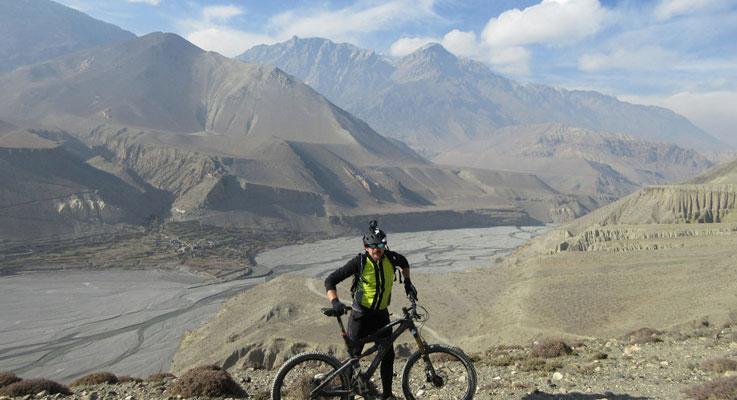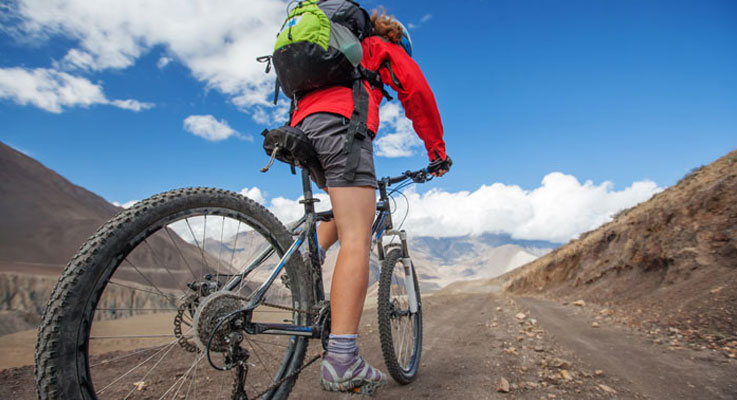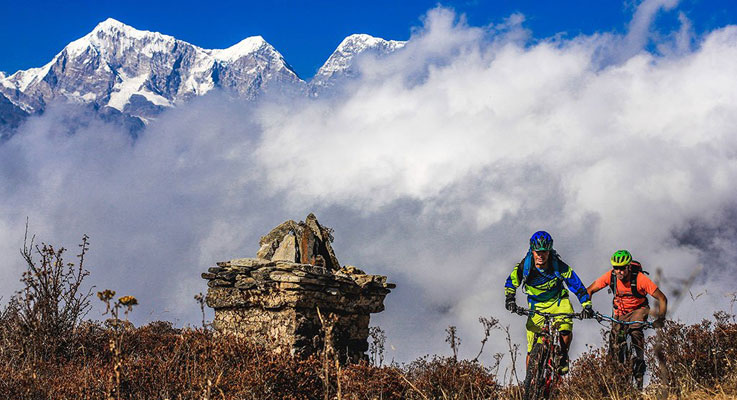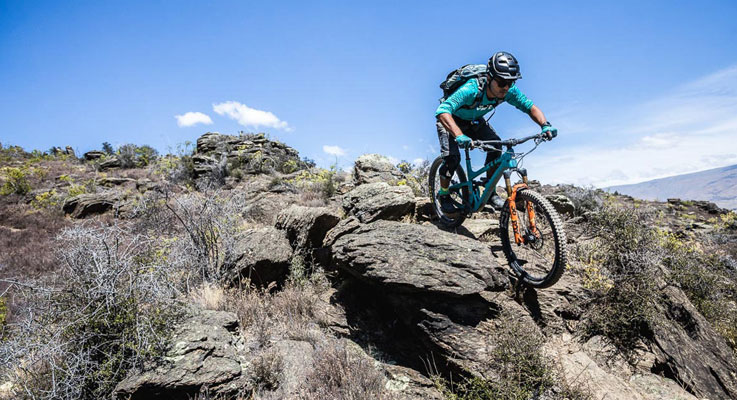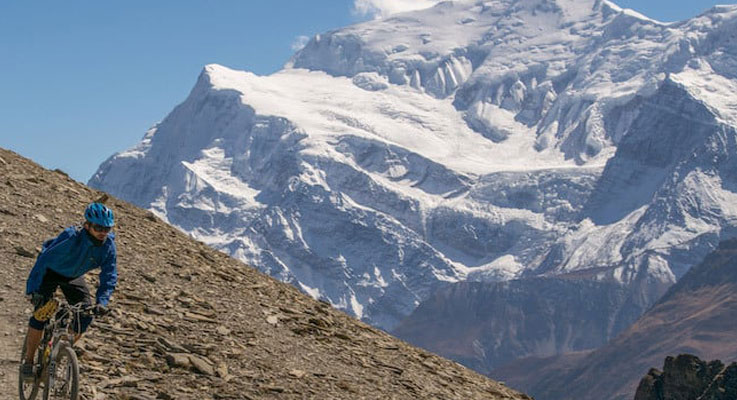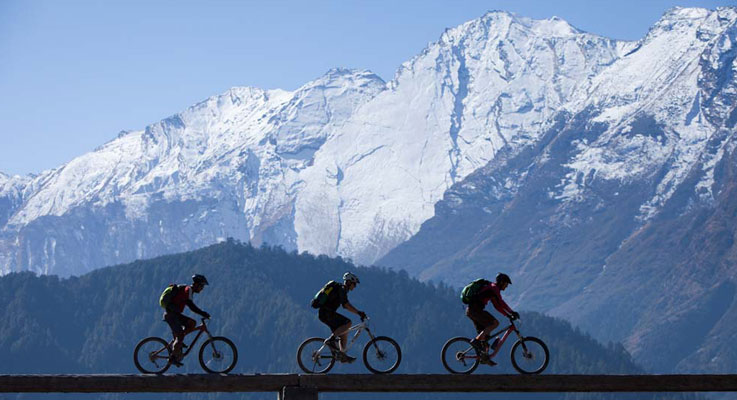-
Day 1
Arrival at the Tribhuwan International Airport in Kathmandu. Some sightseeing and trip briefing
Our staff will welcome you at the Tribhuwan International Airport upon your arrival and transfer you to the hotel on a private vehicle. The evening can be spent exploring Thamel, a tourist hub offering numerous bars, shops and restaurant, as well as Basantapur, which gives you an instant taste of Nepali life. Later in the hotel, we will also brief you on trip details, safety and preparation for the adventure.
-
Day 2
Drive from Kathmandu to Bhaktapur. Bike from Bhaktapur to Godavari
In the morning, we drive to the well preserved ancient town of Bhaktapur Durbar Square, a UNESCO heritage site, on a 45-minute drive. This sightseeing spot is famous for a collection of pagoda and shikhara-style temples, Palace of Fifty-five Windows, museums and art galleries. After having lunch here, we ride south towards Godavari, our destination for the day. Known for the National Botanical Garden which hosts a wide variety of exotic and indigenous plant species, Godavari sits on the foot of the giant Pulchowki peak (2,782m), the highest point in the Kathmandu valley. The tranquility and fresh air in Godavari is unmatched and makes for the perfect place for relaxation!
-
Day 3
Bike from Godavari to Dakshinkali
As we head off from Godavari on jeep tracks, we reach another Newari village of Bungamati, quite popular for Newari food. We’ll do some sightseeing at this exotic place and enjoying the surrounding views, then passing by a preserved lake called Taudaha. From here, we start the ascent to the Hindu temple of Dakshinkali, located on the south side of the valley. The trails are mostly jeep tracks with paved roads in some parts. Dakshinkali is devoted to goddess Kali, the fierce form of Parvati, Shiva’s consort, and is known for animal sacrifices that take place here twice a week and during important Hindu festivals like Dashain. Feel free to wander about this temple nestled in a dense forest, making it a fantastic combination of culture and nature.
-
Day 4
Bike from Dakshinkali to Daman
Cycling by fish farms, old villages and paddy fields, we pass by a reservoir of Nepal’s first hydroelectric power station in Kulekhani. We ride on a mix of jeep tracks and some tarmac as we make our way to Daman. At 2,320 meters in altitude, the serene Daman hillstation rests on the northern slopes of the Mahabharat Range and provides unobstructed views of the Himalayas, including the Everest region on the far eastern side on a crystal clear day. The ride is very pleasant today, and it gives you a taste of the local Nepali culture and a glimpse of the grand Himalayas that Nepal most proudly offers you.
-
Day 5
Bike from Daman to Hetauda
The ride today will be on mostly paved roads as we descend almost 40 kms from Daman to Daman Phedi (meaning the foot of Daman). Then riding mostly on flat tarmac, we’ll reach the Hetauda Valley where we’ll stay in a resort aptly named Life Cycles. Located on the base of the Churia Hills, the lovely resort was started by biking enthusiasts to promote cross-country and downhill biking in this serene valley. Besides biking, there several things you can do here, including trail running, hiking, swimming, relaxation and other outdoor activities. The experience in this quiet little town is one to savor during the trip!
-
Day 6
Rest and Bike around Hetauda
In the morning we’ll ride along beautiful single tracks amidst paddy fields that take us to amazing downhill sections. We’ll explore local villages and observe the local way of life, after which we ride on jeep tracks back to the resort for lunch. In the afternoon, ride along some more single tracks to a small village called Padam Pokhari, from where we ride some downhill sections then back to the resort for some relaxation and a dip in the swimming pool before dinner.
-
Day 7
Bike from Hetauda to Chitwan National Park
Leaving Hetauda, we ride 22 kms on flat tarmac road till the village of Lothar. We take a 28 kms detour at this point to bike on a jeep track to reach the Chitwan National Park, a well preserved sanctuary for endangered species of wildlife and plants established in 1973. Rare animals including one-horned rhinoceros, elephants, Royal Bengal tigers, gharial crocodiles along 700 species of wild animals can be found in this UNESCO World Heritage Site. At the resort, the Guest Relations Officer will brief you about participating in various activities in the national park. These include elephant safari, jungle drive, nature walk, dugout canoe ride, Tharu culture dance, elephant shower, bird watching and so forth.
-
Day 8
Rest day and jungle activities in Chitwan National Park
After an early breakfast, we head off for jungle activities in the morning, because this is the best time to see the wildlife especially for bird watching and jungle walk. Walking an hour or so through the grassland and lush forest upstream of Narayani River, we climb aboard local boats and drift down the river towards our camp, observing crocodiles on the river banks. Later in the day, you will be invited for an elephant safari by the jungle guide and a walk to the observation deck as well as the breeding center. We can explore the local Tharu village and also join them for a traditional dance.
-
Day 9
Bike from Chitwan to Narayanghat. Drive from Narayanghat to Lumbini
From Chitwan, we bike 35 kms through Bishajar Taal and small villages to reach Narayanghat town, from where we set off on a 5-hour drive to Lumbini, the birthplace of Lord Buddha born in 623 BC. Buddhist pilgrims and tourists, alike, visit Lumbini not merely to worship the actual shrine, but also to visit several monasteries and monuments built in the premises by different countries like Japan, Germany, Thailand and Sri Lanka. This pilgrimage site is also a popular route for backpackers and traders heading to India, which lies just 27 kms from this pilgrimage site.
-
Day 10
Bike from Lumbini to Tansen
We leave Lumbini on our bikes and make our way towards Butwal on an alternative route. Upon reaching Butwal, we are westbound to the scenic town of Tansen. The old Newari settlement is known for numerous religious festivals and cultural events and hosts attractions like the Srinagar hill, Tansen Bazar, the centuries-old Ranighat Palace along gorgeous architecture and traditional lifestyle. You’ll find ample photo opportunities in this small town filled with traditional, natural and historical places of interest.
-
Day 11
Bike from Tansen to Pokhara
Our journey continues from Tansen on tarmac to the picturesque valley of Pokhara. With a spectacular skyline of Machapuchare as well as the Annapurna and Dhaulagiri ranges, Pokhara is well known for its peaceful ambience and flowers that blossom year round. There are numerous places to discover and activities to do in Pokhara. We can start off with a relaxing boat ride on the Phewa Lake admiring the mountains at a distance. Don’t forget to shop for souvenirs in shops along the lakeside area and have a chilled bear at Pokhara’s famous bars.
-
Day 12
Hike in Pokhara. Full body massage in the evening
With magnificent hills surrounding the valley, the options for hiking in Pokhara are innumerable. Today, we head to Pokhara’s less touched Begnas Lake to hike on the first stretch of the Royal Trek, so named after Prince Charles trekked this route in 1980 with an entourage of 90 guests. Spectacular mountains, green terraced fields, amazing indigenous lifestyles, local hospitality as well as diverse flora and fauna mark this easy and pleasurable 4-hour hike. In the evening, loosen up your muscles and free your mind with an hour-long full body massage.
-
Day 13
Rest day and sightseeing in Pokhara
We spend the day exploring the picturesque Pokhara valley which offers wonderful natural and cultural places for sightseeing. We visit Barahi Temple (a small island in Phewa Lake), Seti River gorges, Devi’s Fall, Gupteshwar Cave, Tibetan Refugee Camps and a few museums. The Peace Pagoda is also quite a spectacular hike with amazing views of Pokhara valley below and the Annapurnas to the north. The natural beauty and the laid back environment, above all, are what distinguish this city from the rest. Take your adventure one notch up and try the adrenaline-pumping paragliding, microlight flights and zipline over Pokhara (paid separately).
-
Day 14
Fly from Pokhara to Kathmandu. Sightseeing in Kathmandu. Farewell dinner in the evening
Our staff will take you to the airport for an early morning flight to Kathmandu, and transfer you to the hotel. We’ll have some time for sightseeing in the afternoon. Some of the places we visit include UNESCO World Heritage Sites like Bouddhanath (the largest Buddhist shrine in the world), Pashupatinath (the holiest Hindu temples in the world), and Swayambhunath (a popular stupa perched on a hillock overlooking the city). Experiencing the traditional Nepalese lifestyle, mixing in with holy sadhus and monks, learning about fascinating history and observing the enchanting architecture will be the highlight of the day. In the evening, we toast a round or two of locally brewed drinks to celebrate our achievement and to good health!
Holidays should never have an ending date. So extend your trip and whet your appetite for adventure with a host of activities including trekking, bungy jumping, mountain flight, rafting, hiking, and shopping tours. These can be arranged before or after this trip.
-
Day 15
Flight departure from Nepal
The trip concludes today. Our staff will drop you off at the Tribhuwan International Airport and wish you bon voyage for onward journey.

